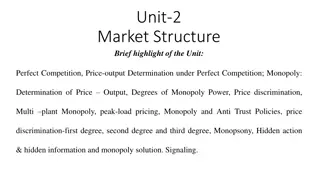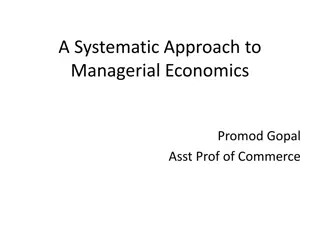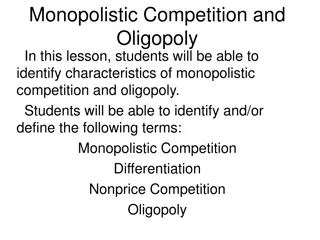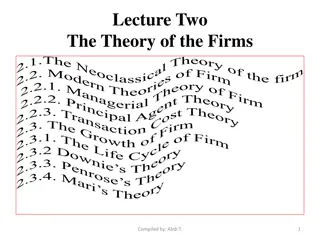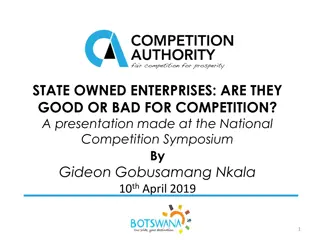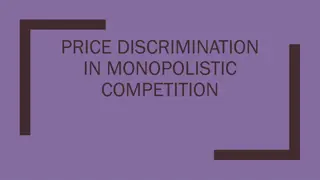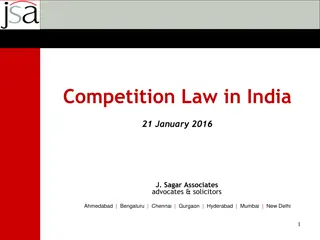Monopolistic Competition and Game Theory in Managerial Economics
Exploring the concepts of monopolistic competition, market structures, equilibrium conditions, and strategic behavior in managerial economics. The content covers aspects like differentiated products, pricing strategies, game theory applications, and optimal decision-making within competitive frameworks. Dr. Sumudu Perera provides insightful discussions on market dynamics, interdependence of outcomes, Nash Equilibrium, and strategic advertising scenarios.
Download Presentation

Please find below an Image/Link to download the presentation.
The content on the website is provided AS IS for your information and personal use only. It may not be sold, licensed, or shared on other websites without obtaining consent from the author.If you encounter any issues during the download, it is possible that the publisher has removed the file from their server.
You are allowed to download the files provided on this website for personal or commercial use, subject to the condition that they are used lawfully. All files are the property of their respective owners.
The content on the website is provided AS IS for your information and personal use only. It may not be sold, licensed, or shared on other websites without obtaining consent from the author.
E N D
Presentation Transcript
BEC 30325: MANAGERIAL ECONOMICS Session 11 MARKET STRUCTURES PART III Dr. Sumudu Perera
Monopolistic Competition Many sellers of differentiated (similar but not identical) products Limited monopoly power Downward-sloping demand curve Increase in market share by competitors causes decrease in demand for the firm s product
Monopolistic Competition Short-Run Equilibrium
Monopolistic Competition Long-Run Equilibrium Profit = 0
Monopolistic Competition Long-Run Equilibrium Cost with selling expenses Cost without selling expenses
BEC 30325: MANAGERIAL ECONOMICS Session 11 GAME THEORY AND STRATEGIC BEHAVIOR Dr. Sumudu Perera
Session Outline 7 Strategic Behavior Prisoners Dilemma Extensions of Game Theory 11/10/ 2024 Dr.Sumudu Perera
Strategic Behavior Decisions that take into account the predicted reactions of rival firms Interdependence of outcomes Game Theory Players Strategies Payoff matrix
Strategic Behavior Types of Games Zero-sum games Nonzero-sum games Nash Equilibrium Each player chooses a strategy that is optimal given the strategy of the other player A strategy is dominant if it is optimal regardless of what the other player does
Advertising Example 1 Firm B Advertise (4, 3) (2, 5) Don't Advertise (5, 1) (3, 2) Advertise Don't Advertise Firm A
Advertising Example 1 What is the optimal strategy for Firm A if Firm B chooses to advertise? Firm B Advertise (4, 3) (2, 5) Don't Advertise (5, 1) (3, 2) Advertise Don't Advertise Firm A
Advertising Example 1 What is the optimal strategy for Firm A if Firm B chooses to advertise? If Firm A chooses to advertise, the payoff is 4. Otherwise, the payoff is 2. The optimal strategy is to advertise. Firm B Advertise (4, 3) (2, 5) Don't Advertise (5, 1) (3, 2) Advertise Don't Advertise Firm A
Advertising Example 1 What is the optimal strategy for Firm A if Firm B chooses not to advertise? Firm B Advertise (4, 3) (2, 5) Don't Advertise (5, 1) (3, 2) Advertise Don't Advertise Firm A
Advertising Example 1 What is the optimal strategy for Firm A if Firm B chooses not to advertise? If Firm A chooses to advertise, the payoff is 5. Otherwise, the payoff is 3. Again, the optimal strategy is to advertise. Firm B Advertise (4, 3) (2, 5) Don't Advertise (5, 1) (3, 2) Advertise Don't Advertise Firm A
Advertising Example 1 Regardless of what Firm B decides to do, the optimal strategy for Firm A is to advertise. The dominant strategy for Firm A is to advertise. Firm B Advertise (4, 3) (2, 5) Don't Advertise (5, 1) (3, 2) Advertise Don't Advertise Firm A
Advertising Example 1 What is the optimal strategy for Firm B if Firm A chooses to advertise? Firm B Advertise (4, 3) (2, 5) Don't Advertise (5, 1) (3, 2) Advertise Don't Advertise Firm A
Advertising Example 1 What is the optimal strategy for Firm B if Firm A chooses to advertise? If Firm B chooses to advertise, the payoff is 3. Otherwise, the payoff is 1. The optimal strategy is to advertise. Firm B Advertise (4, 3) (2, 5) Don't Advertise (5, 1) (3, 2) Advertise Don't Advertise Firm A
Advertising Example 1 What is the optimal strategy for Firm B if Firm A chooses not to advertise? Firm B Advertise (4, 3) (2, 5) Don't Advertise (5, 1) (3, 2) Advertise Don't Advertise Firm A
Advertising Example 1 What is the optimal strategy for Firm B if Firm A chooses not to advertise? If Firm B chooses to advertise, the payoff is 5. Otherwise, the payoff is 2. Again, the optimal strategy is to advertise. Firm B Advertise (4, 3) (2, 5) Don't Advertise (5, 1) (3, 2) Advertise Don't Advertise Firm A
Advertising Example 1 Regardless of what Firm A decides to do, the optimal strategy for Firm B is to advertise. The dominant strategy for Firm B is to advertise. Firm B Advertise (4, 3) (2, 5) Don't Advertise (5, 1) (3, 2) Advertise Don't Advertise Firm A
Advertising Example 1 The dominant strategy for Firm A is to advertise and the dominant strategy for Firm B is to advertise. The Nash equilibrium is for both firms to advertise. Firm B Advertise (4, 3) (2, 5) Don't Advertise (5, 1) (3, 2) Advertise Don't Advertise Firm A
Advertising Example 2 Firm B Advertise (4, 3) (2, 5) Don't Advertise (5, 1) (6, 2) Advertise Don't Advertise Firm A
Advertising Example 2 What is the optimal strategy for Firm A if Firm B chooses to advertise? Firm B Advertise (4, 3) (2, 5) Don't Advertise (5, 1) (6, 2) Advertise Don't Advertise Firm A
Advertising Example 2 What is the optimal strategy for Firm A if Firm B chooses to advertise? If Firm A chooses to advertise, the payoff is 4. Otherwise, the payoff is 2. The optimal strategy is to advertise. Firm B Advertise (4, 3) (2, 5) Don't Advertise (5, 1) (6, 2) Advertise Don't Advertise Firm A
Advertising Example 2 What is the optimal strategy for Firm A if Firm B chooses not to advertise? Firm B Advertise (4, 3) (2, 5) Don't Advertise (5, 1) (6, 2) Advertise Don't Advertise Firm A
Advertising Example 2 What is the optimal strategy for Firm A if Firm B chooses not to advertise? If Firm A chooses to advertise, the payoff is 5. Otherwise, the payoff is 6. In this case, the optimal strategy is not to advertise. Firm B Advertise (4, 3) (2, 5) Don't Advertise (5, 1) (6, 2) Advertise Don't Advertise Firm A
Advertising Example 2 The optimal strategy for Firm A depends on which strategy is chosen by Firms B. Firm A does not have a dominant strategy. Firm B Advertise (4, 3) (2, 5) Don't Advertise (5, 1) (6, 2) Advertise Don't Advertise Firm A
Advertising Example 2 What is the optimal strategy for Firm B if Firm A chooses to advertise? Firm B Advertise (4, 3) (2, 5) Don't Advertise (5, 1) (6, 2) Advertise Don't Advertise Firm A
Advertising Example 2 What is the optimal strategy for Firm B if Firm A chooses to advertise? If Firm B chooses to advertise, the payoff is 3. Otherwise, the payoff is 1. The optimal strategy is to advertise. Firm B Advertise (4, 3) (2, 5) Don't Advertise (5, 1) (6, 2) Advertise Don't Advertise Firm A
Advertising Example 2 What is the optimal strategy for Firm B if Firm A chooses not to advertise? Firm B Advertise (4, 3) (2, 5) Don't Advertise (5, 1) (6, 2) Advertise Don't Advertise Firm A
Advertising Example 2 What is the optimal strategy for Firm B if Firm A chooses not to advertise? If Firm B chooses to advertise, the payoff is 5. Otherwise, the payoff is 2. Again, the optimal strategy is to advertise. Firm B Advertise (4, 3) (2, 5) Don't Advertise (5, 1) (6, 2) Advertise Don't Advertise Firm A
Advertising Example 2 Regardless of what Firm A decides to do, the optimal strategy for Firm B is to advertise. The dominant strategy for Firm B is to advertise. Firm B Advertise (4, 3) (2, 5) Don't Advertise (5, 1) (6, 2) Advertise Don't Advertise Firm A
Advertising Example 2 The dominant strategy for Firm B is to advertise. If Firm B chooses to advertise, then the optimal strategy for Firm A is to advertise. The Nash equilibrium is for both firms to advertise. Firm B Advertise (4, 3) (2, 5) Don't Advertise (5, 1) (3, 2) Advertise Don't Advertise Firm A
Prisoners Dilemma Two suspects are arrested for armed robbery. They are immediately separated. If convicted, they will get a term of 10 years in prison. However, the evidence is not sufficient to convict them of more than the crime of possessing stolen goods, which carries a sentence of only 1 year. The suspects are told the following: If you confess and your accomplice does not, you will go free. If you do not confess and your accomplice does, you will get 10 years in prison. If you both confess, you will both get 5 years in prison.
Prisoners Dilemma Payoff Matrix (negative values) Individual B Confess (5, 5) (10, 0) Don't Confess (0, 10) (1, 1) Confess Don't Confess Individual A
Prisoners Dilemma Dominant Strategy Both Individuals Confess (Nash Equilibrium) Individual B Confess (5, 5) (10, 0) Don't Confess (0, 10) (1, 1) Confess Don't Confess Individual A
Prisoners Dilemma Application: Price Competition Firm B Low Price (2, 2) (1, 5) High Price (5, 1) (3, 3) Low Price High Price Firm A
Prisoners Dilemma Application: Price Competition Dominant Strategy: Low Price Firm B Low Price (2, 2) (1, 5) High Price (5, 1) (3, 3) Low Price High Price Firm A
Prisoners Dilemma Application: Nonprice Competition Firm B Advertise (2, 2) (1, 5) Don't Advertise (5, 1) (3, 3) Advertise Don't Advertise Firm A
Prisoners Dilemma Application: Nonprice Competition Dominant Strategy: Advertise Firm B Advertise (2, 2) (1, 5) Don't Advertise (5, 1) (3, 3) Advertise Don't Advertise Firm A
Prisoners Dilemma Application: Cartel Cheating Firm B Cheat (2, 2) (1, 5) Don't Cheat (5, 1) (3, 3) Cheat Don't Cheat Firm A
Prisoners Dilemma Application: Cartel Cheating Dominant Strategy: Cheat Firm B Cheat (2, 2) (1, 5) Don't Cheat (5, 1) (3, 3) Cheat Don't Cheat Firm A
Extensions of Game Theory Repeated Games Many consecutive moves and countermoves by each player Tit-For-Tat Strategy Do to your opponent what your opponent has just done to you
Extensions of Game Theory Tit-For-Tat Strategy Stable set of players Small number of players Easy detection of cheating Stable demand and cost conditions Game repeated a large and uncertain number of times
Extensions of Game Theory Threat Strategies Credibility Reputation Commitment Example: Entry deterrence






